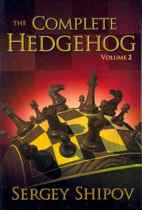Complete Hedgehog — Volume 2, The
Sergey Shipov

One opening that first came into fashion on the 1970s was the Hedgehog. Named after the small spiny mammal that uses its quills for defense, this opening setup is characterized by Black shedding his c-pawn for Whites d-pawn and then fianchettoing his queen Bishop while placing many of his pawns on the third rank. White has a space advantage from the opening but attempts to translate this into something concrete like a kingside attack are often rebuffed by Blacks resilient structure in which breaks with …b5 or …d5 signal counterplay.
Russian GM Sergey Shipov is one of the worlds leading experts on this structure and in late 2009 Mongoose Press published the first of his two volumes on the subject which covered the Hedgehog via 1.Nf3 and 1.c4. Over 500 pages in length, it was justly praised for both its insights and comprehensive coverage. His followup volume, just out, The Complete Hedgehog Volume 2 is a monster of a book.
This time Shipov focuses on the Hedgehog via 1.d4 or 1.e4. The subject matter covered is:
Part 1: The Hedgehog with a Pawn on f3
Section 1. Blacks main ideas.
Chapter 1-1. The main ideas of the structure. The canonical setup for Black.
Opening the center with the attack
d6-d5.
Chapter 1-2. The Sämisch Maneuver Transferring the bishop to c7.
Chapter 1-3. Fischers plan. Raid by the g7-pawn.
Chapter 1-4. Ljubojevićs plan a diversion by the h7-pawn.
Section 2. Active plans for White. Modern theory.
A lyrical retreat: The professors lessons.
Chapter 2-1. Early raid by the a2-pawn a modification of the classic plan.
Chapter 2-2. Pressure on the d6 pawn with an exchange on e5.
Chapter 2-3. A pawn assault by White on the kingside.
Chapter 2-4. White castles queenside. Assault on the kingside.
Part 2: The Hedgehog with a Bishop on the b1-h7 Diagonal
Chapter 1. Sources and general ideas. A bishop on b2.
Chapter 2. The wanderings of the c1-bishop. Variations in Whites structure.
Part 3: The Queens Indian Hedgehog
Opposite-side castling in the Petrosian variation.
I had always assumed the Hedgehog developed in the 1970s and that maneuvers like …Be7-d8-c7 dated back no further than the 1960s at most. Imagine my surprise to discover that Fritz Saemisch had come up with this idea against Opocensky (Bad Pistyan 1922) decades before. Saemisch might not go down in chess history as the strongest of GMs, but to discover a major line of the Kings Indian (5.f3) and Nimzo-Indian (4.a3) as well as …Be7-d8-c7 is pretty impressive.
To say that The Complete Hedgehog Volume 2 is comprehensive would be an understatement, but despite being the size of a small phone book it is highly readable due to the authors engaging style. I, for one, enjoyed his stories, particularly his recounting of the trials and tribulations of Hedgehog pioneer Florin Gheorghiu who suffered many a catastrophic defeat in his favorite opening but always kept coming back for more.
Highly Recommended
Click to see the review of The Complete Hedgehog Volume 1
